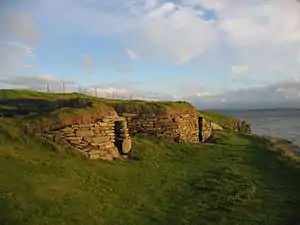The following events occurred in architecture in the 4th millennium BC:
Buildings and structures
Buildings
- Sialk ziggurat near Kashan, Iran (3200BCE)[1]
- Ġgantija – megalithic temple complex on the island of Gozo (part of Malta, c.3600–2500 BCE)
- Harappa – fortified city of the Indus Valley civilization with as many as 40,000 residents (3300–1600 BCE)

Knap of Howar on Orkney island
- Northern Europe
- Céide Fields – oldest known field systems in the world, located in West Ireland
- Brú na Bóinne complex – Neolithic passage tombs in County Meath, Ireland (c.3300–2900 BCE)
- Knap of Howar – oldest preserved stone house in northern Europe, on the Orkney island of Papa Westray occupied from 3500 to 3100 BCE
- Skara Brae – Europe's most complete Neolithic village located in the Bay of Skaill in Orkney, Scotland
- Stonehenge – the earliest phase of the monument has been dated to about 3100 BCE
- Sweet Track – oldest known engineered roadway located in Shapwick, Somerset, England (3806 BCE)
See also
References
- ↑ Kohl, Philip L.; Bäck, Lucien R.; Claessen, Henri J. M.; Gilman, Antonio; Hamlin, Christopher L.; Hayashi, Kensaku; Lamberg-Karlovsky, C. C.; Nissen, Hans J.; Oates, Joan (1978-09-01). "The Balance of Trade in Southwestern Asia in the Mid-Third Millennium B.C. [and Comments and Reply]". Current Anthropology. 19 (3): 463–492. doi:10.1086/202136. JSTOR 2741769.
This article is issued from Wikipedia. The text is licensed under Creative Commons - Attribution - Sharealike. Additional terms may apply for the media files.